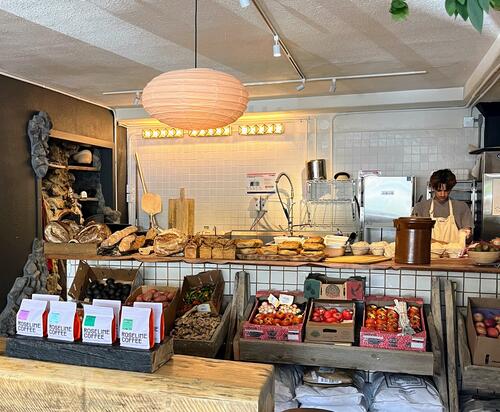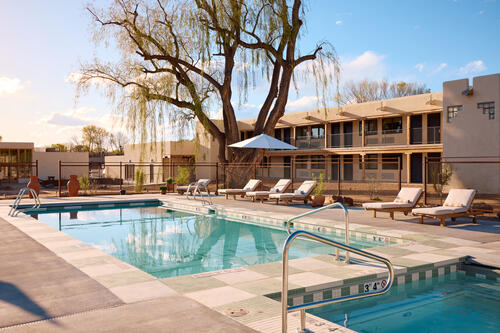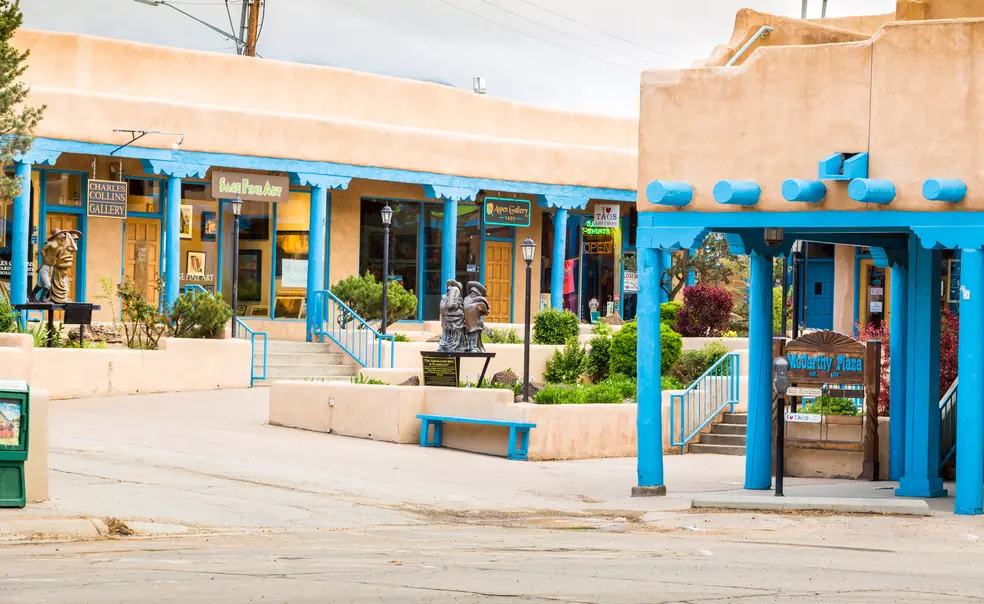The Magic Is Back in Legendary Taos, New Mexico
Taos is undergoing a revival worthy of its storied history and mystical reputation, Harrison Blackman ’17 writes
Off Route 64 in New Mexico, inside a Pueblo Revival building of adobe and flying vigas, you’ll find Tomorrow and Tomorrow, a café with bespoke wooden furniture, an espresso bar, and in the back, a sourdough bread oven alongside a Parisian-inflected épicerie (convenience store). Drawing its name from a Macbeth speech about the fleeting nature of life, the space is populated by creative types in cowboy hats and linen pants locked in lively conversations, glued to the Slack chat on their MacBook Pros — or, better yet, wolfing down the decadent sourdough bread BLTs in front of them.
The fact that a place like Tomorrow and Tomorrow is in Taos, New Mexico, in the year 2025 — and not in Santa Fe, or Austin, or any number of more upscale Southwestern communities — may come as something of a shock.

Taos has a mythic place within the firmament of the Wild West. Home of Taos Pueblo, believed to be the oldest continuously inhabited building in North America, Taos’ syncretic culture has long combined Indigenous influences with those of the 16th-century Spanish conquistadors, as well as the more recent additions of early 20th century writers and artists (such as D.H. Lawrence and Mabel Dodge Luhan) and 1960s countercultural icons (including combustible movie star Dennis Hopper). Those in the know might say that Taos is an otherworldly, mystical place where chance encounters unlock horizons and sway destinies; where some residents report hearing a mysterious ultrasonic “Hum.” It’s the kind of place where, if your car breaks down in the vicinity of the charismatic Sangre de Cristo mountains, you might just settle down and stay forever.
That historic legacy fascinated me in 2017, the summer after I graduated Princeton, when I served as the reporting intern for the local newspaper, The Taos News. But even then, it was clear that some of the Taos magic had faded. The historic Taos Plaza, once the main setting of town life (and death, as it once hosted public hangings), had long been converted into a tourist trap — a sort of Westworld hawking dreamcatchers and lackluster imitations of Georgia O’Keeffe. During my reporting stint, I often covered retail closures, petty crime, and the progress of a proposed Holiday Inn that, eight years later, never materialized.
Yet in the intervening period of pandemic and recovery, a transformation in Taos had begun. New arrivals — many of them creatives from places such as Los Angeles and St. Louis — sought to bring fresh ideas (and significant investments) to a town sometimes burdened with its weighty past.

Tomorrow and Tomorrow founder Matt Burns is one of those people. Burns grew up as an unlikely vegan in Sioux Falls, South Dakota, pursuing a multifarious career as a Hollywood actor and creator of a Brooklyn salsa brand and Catskills supper club before his post-pandemic Taos arrival. To meet more people in the community, Burns opened the café in 2024. “This place reminds a lot of people of a lot of different things,” Burns reflects. “It’s not necessarily what they would expect to find in Taos. In my opinion, it couldn’t be more Taos.”
Farther up the road, playful statuary guard the path to Revolt Gallery, the project of Missouri native Steve McFarland, who came to Taos in 2006 when a friend encouraged him to join him for a land auction. The land auction turned out to be a mirage, but when they visited an “Earthship” (a type of sustainable housing built from tires and other detritus by local architect Michael Reynolds), some of the old Taos magic started up again.
The Earthship’s resident, a total stranger to McFarland, remarked that “you guys were in my dream last night,” and accurately guessed that they were in town to buy land, which the man’s father just so happened to be selling. “I’m just like, oh my gosh, this is meant to be,” McFarland recalls.
In the Land of Enchantment, McFarland found himself enchanted. He bought 3/4 of an acre on the mesa, building his own home over four years so that he could live in Taos full time, and in 2017, he founded Revolt. Named in homage to historic uprisings in Taos (including one down the street, in which the first American governor of New Mexico was assassinated in 1847), Revolt has upgraded the art scene with a space for contemporary artists, partnering with art programs at the University of New Mexico and the School of Visual Arts in New York. “I don’t want to show what everybody else is showing,” McFarland says, explaining that his gallery is intended to showcase the work of underrepresented communities, featuring artists like Jaime C. Knight, who investigates queer subjects, and Cougar Vigil, an artist of the Jicarilla Apache Nation.
Then there’s Hotel Willa, a once blighted motel dating back to the 1940s, newly renovated. The Casetta Group opened it as a boutique hotel in 2025, with its own gallery of contemporary Taos art, EV charging stations, and one of the only bars near Taos’s historic plaza open till midnight — all under the shade of a magnificent 200-year-old willow.
“We saw tremendous value in the bones of the property in the midcentury design, the vintage signage, and the courtyard layout,” says hotel manager Santiago La Roche. “It was important for us to preserve the original while giving it new life, staying true to both the building’s heritage and the evolving needs of today’s travelers.”
Old and new have a way of mixing in Taos. Any visit to this Taos-fusion would be incomplete without attending a dinner at the Stakeout, which offers an exhilarating view of the Rio Grande Gorge from the vantage of Outlaw Hill, supposedly a former hideout of Billy the Kid. As the Stakeout doubles as a Mission Revival-styled wedding venue, its restaurant is open only on Sunday evenings, but the wait is worth it — visitors can peruse a handwritten menu, listen to live folk music, and sip craft tequila and gin cocktails while sampling everything from steak frites to collard greens. Here, watching the sunset crest over the mesa and bathe the gnarled branches of nearby piñon with an orange glow, you’ll realize why so many cultures have called Taos home.

Where to Stay
Hotel Willa. From $235/night.
What to Eat
Chokolá, the bean-to-bar brainchild of chocolatier Debi Vincent, who grew up in Venezuela as the daughter of an American Fulbright scholar from Taos, offers a selection of chocolate sourced from select cacao growers across the world.
For an elevated experience, visit Suchness. Named for the Buddhist concept of Tathātā, a state of pure perception, Suchness offers riffs on local cuisine, such as its atole de grano (a hot masa porridge of Mesoamerican origins) while also serving upscale takes on sea bass and lamb shoulder.
Getting There
Most visitors fly into Albuquerque International Airport (ABQ), the state’s largest, and take the Taos Ski Valley shuttle or rent a car to make the 133-mile trek to Taos. However, new routes from public charter operators JSX and Contour Airlines offer direct connections from Burbank Hollywood Airport (BUR) and Denver International Airport (DEN), respectively, to Taos Regional Airport (TSM). These services sell seats on charter flights — i.e., customers buy business class–equivalent seats on what amounts to a “semi-private jet” — featuring private terminals and laxer TSA screening requirements, albeit with less frequent service than most commercial airlines.
Harrison Blackman ’17 is a freelance writer and journalist based in Los Angeles. He was a reporting intern at The Taos News in 2017.












1 Response
George Chang ’63
2 Months AgoNorthern and Southern New Mexico
Nice to see this article!
I’d just like to remind readers that Taos is in Northern New Mexico, hundreds of miles north of Southern New Mexico. The differences between Northern and Southern New Mexico are as striking as the differences between Northern California and Southern California.
For example, Northern New Mexico was decidedly “Union” during the American Civil War. Contrast this to Southern New Mexico, where the citizens of Mesilla voted to join the Confederacy a full half year before Virginia did.